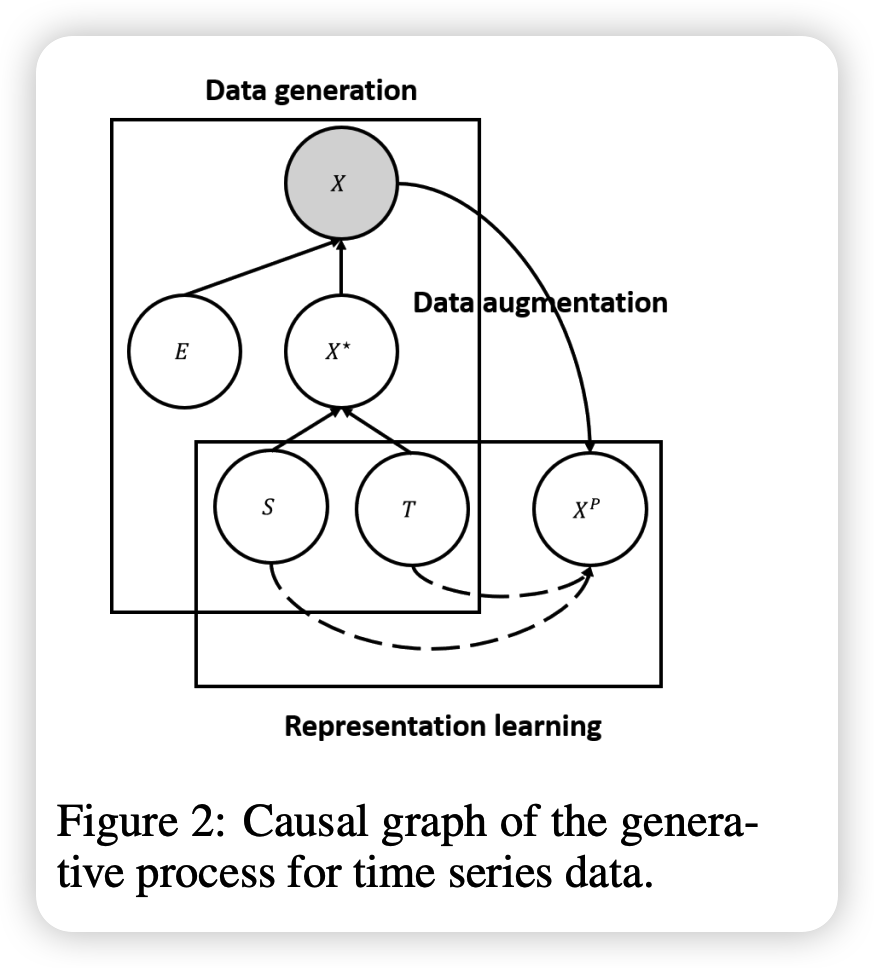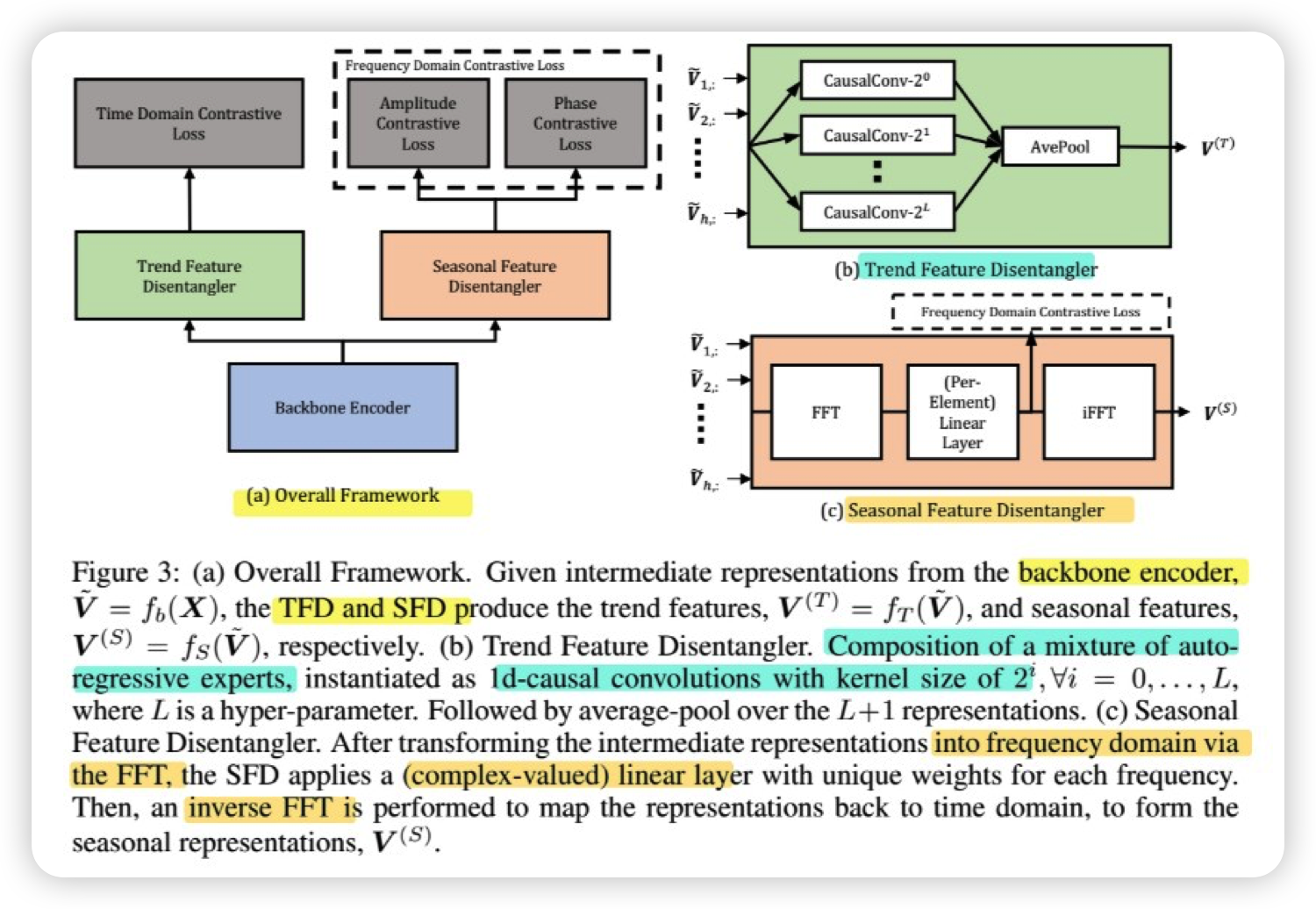COST ; Contrastive Learning of Disentangled Seasonal-Trend Representations for TS forecasting (2022)
Contents
- Abstract
- Introduction
- Seasonal-Trend Representation for TS
- Seasonal-Trend Contrastive Learning Framework
- Trend Feature Representations
- Seasonal Fetaure Representations
0. Abstract
promising paradigm for TS forecasting :
- (step 1) learn disentangled feature representations,
- (step 2) simple regression fine-tuning step
from a causal perspective
CoST
-
propose a new TS representation learning framework
- applies contrastive learning methods, to learn disentangled seasonal-trend representations
- comprises both
- (1) time domain contrastive losses
- (2) frequency domain contrastive losses
1. Introduction
End-to-End (X)
-
end to end ( learned representations & predictions )
\(\rightarrow\) unable to transfer nor generalize well!
-
Thus, aim to learn disentangled seasonal-trend representations
Leverage the idea of Structural TS models
- TS = T + S + error
CoST
= Contrastive Learning of Disentangled Seasonal-Trend Representations for TS forecasting
- leverages inductive biases in the model architecture
- efficiently learns Trend representations
- mitigating the problem of lookback window selection, by introducing a mixture of auto-regressive experts
- learns powerful Seasonal representations
- by leveraging a learnable Fourier layer
- enables intra-frequency interactions
- domain
- TREND : time domain
- SEASONALITY : frequency domain
2. Seasonal-Trend Representation for TS
(1) Problem Formulation
Notation
- \(\left(\boldsymbol{x}_{1}, \ldots \boldsymbol{x}_{T}\right) \in \mathbb{R}^{T \times m}\) : MTS
- \(h\) : lookback window
- \(k\) : forecasting horizon
- \(\hat{\boldsymbol{X}}=g(\boldsymbol{X})\) : model
- \(\boldsymbol{X} \in \mathbb{R}^{h \times m}\) : input
- \(\hat{\boldsymbol{X}} \in \mathbb{R}^{k \times m}\) : output
Not an end-to-end model!
- instead, focus on learning feature representations from observed data
- aim to learn a nonlinear feature embedding function \(\boldsymbol{V}=f(\boldsymbol{X})\),
- where \(\boldsymbol{X} \in \mathbb{R}^{h \times m}\) and \(\boldsymbol{V} \in \mathbb{R}^{h \times d}\),
- map per each timestamp
Then, using the learned representations of the final timestamp \(\boldsymbol{v}_{h}\)
\(\rightarrow\) used as inputs for the downstream regressor of the forecasting task.
(2) Disentanged Seasonal-Trend Representation Learning and its Causal interpretation
Introduce structural priors for TS
- use Bayesian Structural Time Series Model

Assumption 1
- observed TS : \(X\) is generated from…
- (1) \(E\) : error variable
- (2) \(X^{\star}\) : error-free latent variable : generated from…
- (2-1) \(T\) : trend variable
- (2-2) \(S\) : seasonal variable
- Since \(E\) is not predictable…focus on \(X^{\star}\)
Assumption 2 : Independent mechanism
-
season & trend do not interact with each other
\(\rightarrow\) disentangle S & T
Learning representations for \(S\) & \(T\)
- allows us to find stable result
- since targets \(X^{\star}\) are unknown…. construct a proxy CONTRASTIVE learning task
3. Seasonal-Trend Contrastive Learning Framework
CoST framework
- learn disentangled seasonal-trend reperesentation
- for each time step, have the disentangled representations for S & T
- \(\boldsymbol{V}=\left[\boldsymbol{V}^{(T)} ; \boldsymbol{V}^{(S)}\right] \in \mathbb{R}^{h \times d}\).
- trend : \(\boldsymbol{V}^{(T)} \in \mathbb{R}^{h \times d_{T}}\)
- season : \(\boldsymbol{V}^{(S)} \in \mathbb{R}^{h \times d_{S}}\)
- \(\boldsymbol{V}=\left[\boldsymbol{V}^{(T)} ; \boldsymbol{V}^{(S)}\right] \in \mathbb{R}^{h \times d}\).

Step 1) : encoder
- encoder : \(f_{b} : \mathbb{R}^{h \times m} \rightarrow \mathbb{R}^{h \times d}\)
- map into latent space ( = intermediate representation )
Step 2) : trend & seasonal representation
- from intermediate representations..
- (1) TFD ( Trend Feature Disentagler ) : \(f_{T}: \mathbb{R}^{h \times d} \rightarrow \mathbb{R}^{h \times d_{T}}\)
- extracts trend representation,
- via a mixture of AR experts
- learned via a time domain constrastive loss \(L_{time}\)
- (2) SFD ( Seasonal Feature Disentagler ) : \(f_{S}: \mathbb{R}^{h \times d} \rightarrow \mathbb{R}^{h \times d_{S}}\)
- extracts seasonal representation,
- via a learnable Fourier layer
- learned via frequency domain constrastive loss, which consists of
- a) \(L_{amp}\) : amplitude component
- b) \(L_{phase}\) : phase component
- (1) TFD ( Trend Feature Disentagler ) : \(f_{T}: \mathbb{R}^{h \times d} \rightarrow \mathbb{R}^{h \times d_{T}}\)
- overall loss function :
- \(\mathcal{L}=\mathcal{L}_{\text {time }}+\frac{\alpha}{2}\left(\mathcal{L}_{\mathrm{amp}}+\mathcal{L}_{\text {phase }}\right)\).
- \(\alpha\) : trade-off between \(T\) & \(S\)
- \(\mathcal{L}=\mathcal{L}_{\text {time }}+\frac{\alpha}{2}\left(\mathcal{L}_{\mathrm{amp}}+\mathcal{L}_{\text {phase }}\right)\).
Step 3) concatenate
Concatenate the outputs of Trend and Seasonal Feature Disentaglers,
to obtain final output representations
(1) Trend Feature Representations
Autoregressive filtering
-
able to capture time-lagged causal relationships from past observation
-
problem : how to select lookback window?
\(\rightarrow\) propose to use a MIXUTRE of auto-regressive exports
( adaptively select the appropriate lookback window )
Trend Feature Disentangler (TFD)
-
mixture of \(L+1\) autoregressive experts
-
implemented as 1-d causal convolution
- input channel : \(d\)
-
output channel : \(d_T\)
- kernel size : \(2^{i}\)
-
each expert : \(\tilde{\boldsymbol{V}}^{(T, i)}=\operatorname{CausalConv}\left(\tilde{\boldsymbol{V}}, 2^{i}\right)\)
-
average-pooling operation :
- \(\boldsymbol{V}^{(T)}=\operatorname{AvePool}\left(\tilde{\boldsymbol{V}}^{(T, 0)}, \tilde{\boldsymbol{V}}^{(T, 1)}, \ldots, \tilde{\boldsymbol{V}}^{(T, L)}\right)=\frac{1}{(L+1)} \sum_{i=0}^{L} \tilde{\boldsymbol{V}}^{(T, i)}\).
Time Domain Contrastive Loss
- employ contrastive loss in time domain
- Given \(N\) Samples & \(K\) negative samples…
- \(\mathcal{L}_{\text {time }}=\sum_{i=1}^{N}-\log \frac{\exp \left(\boldsymbol{q}_{i} \cdot \boldsymbol{k}_{i} / \tau\right)}{\exp \left(\boldsymbol{q}_{i} \cdot \boldsymbol{k}_{i} / \tau\right)+\sum_{j=1}^{K} \exp \left(\boldsymbol{q}_{i} \cdot \boldsymbol{k}_{j} / \tau\right)}\).
(2) Seasonal Fetaure Representations
spectral analysis in frequency domain
2 issues
-
(1) how to support INTRA-frequency interactions
-
(2) what kind of learning signal is requred to learn representations,
which are able to discriminate between different seasonality patterns
\(\rightarrow\) introduce SFD, which makes use of a learnable Fourier Layer
( SFD = Seasonal Feature Disentangler )
Seasonal Feature Disentangler (SFD)
composed of 2 parts
- (1) DFT (discrete Fourier Transform)
- map intermediate features to FREQUENCY domain ( \(\mathcal{F}(\tilde{\boldsymbol{V}}) \in \mathbb{C}^{F \times d}\) )
- (2) learnable Fourier layer
- map in to \(\boldsymbol{V}^{(S)} \in \mathbb{R}^{h \times d_{S}}\)
Model
- \(V_{i, k}^{(S)}=\mathcal{F}^{-1}\left(\sum_{j=1}^{d} A_{i, j, k} \mathcal{F}(\tilde{\boldsymbol{V}})_{i, j}+B_{i, k}\right)\).
Frequency Domain Contrastive Loss
discriminate between different periodic patterns, given an frequency
- \(\mathcal{L}_{\mathrm{amp}}=\frac{1}{F N} \sum_{i=0}^{F} \sum_{j=1}^{N}-\log \frac{\exp \left( \mid \boldsymbol{F}_{i,:}^{(j)} \mid \cdot \mid \left(\boldsymbol{F}_{i,:}^{(j)}\right)^{\prime} \mid \right)}{\exp \left( \mid \boldsymbol{F}_{i,:}^{(j)} \mid \cdot \mid \left(\boldsymbol{F}_{i,:}^{(j)}\right)^{\prime} \mid \right)+\sum_{k \neq j}^{N} \exp \left( \mid \boldsymbol{F}_{i,:}^{(j)} \mid \cdot \mid \boldsymbol{F}_{i,:}^{(k)} \mid \right)}\).
- \(\mathcal{L}_{\text {phase }}=\frac{1}{F N} \sum_{i=0}^{F} \sum_{j=1}^{N}-\log \frac{\exp \left(\phi\left(\boldsymbol{F}_{i,:}^{(j)}\right) \cdot \phi\left(\left(\boldsymbol{F}_{i,:}^{(j)}\right)^{\prime}\right)\right)}{\exp \left(\phi\left(\boldsymbol{F}_{i,:}^{(j)}\right) \cdot \phi\left(\left(\boldsymbol{F}_{i,:}^{(j)}\right)^{\prime}\right)\right)+\sum_{k \neq j}^{N} \exp \left(\phi\left(\boldsymbol{F}_{i,:}^{(j)}\right) \cdot \phi\left(\boldsymbol{F}_{i,:}^{(k)}\right)\right)}\).
where \(\boldsymbol{F}_{i,:}^{(j)}\) is the \(j\)-th sample in a mini-batch, and \(\left(\boldsymbol{F}_{i,:}^{(j)}\right)^{\prime}\) is the augmented version of that sample.
